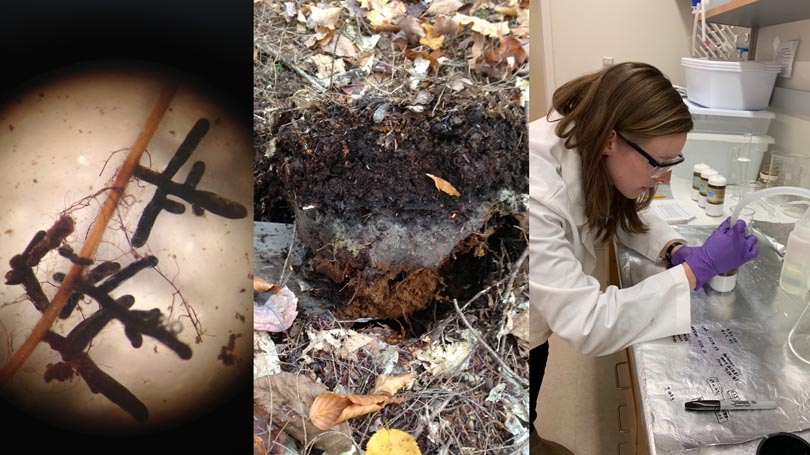
"As we discover more about the world beneath the surface, we can make better estimates of atmospheric carbon dioxide concentrations in the decades to come," Ashley K. Lang (Photo: Ashley Lang)
The Dartmouth Graduate Alumni Research Award is funded through the generosity of alumni of Dartmouth graduate programs. Every school year, graduate students can apply for funding of up to $1000 to support their thesis research.
When you’re walking though the woods, what you can see around you—those towering trees, flitting birds, tiny flowers peeking out from the damp forest floor—is only part of the rich forest ecosystem. To discover the rest, you must look underground.
Forest soil is an ecosystem unto itself. In northern New England, this ecosystem is a beautiful layer cake of soil horizons, each a striking color and with its own distinct chemical and physical properties. Thousands of organisms call this soil home, ranging from salamanders to bacteria. For my dissertation work, I study the effects of a particular group of soil-dwelling fungi on the capacity of forests to capture and store carbon from the atmosphere. This group of fungi—known as mycorrhizal fungi—live on the roots of plants and help plants acquire nutrients from the soil. In exchange, the plant sends them sugars that it produces in its leaves. This ancient mutualism has been instrumental in allowing plants to grow in nutrient-poor soils since the evolution of the first land plants about 425 million years ago.
Though these fungi are small, their activities may have enormous effects on Earth’s climate. My research is focused on understanding how two main groups of mycorrhizal fungi—those living outside of plant roots (ectomycorrhizal, or ECM) and those which integrate with plant root cells (arbuscular mycorrhizal, or AM)—affect how much carbon enters and exits the soil ecosystem. Most tree species form associations with one of these two groups of mycorrhizal fungi. For example, maples and ash trees associate with AM fungi, while birch, beech, and most conifers associate with ECM fungi. This distinction matters because these fungal groups function differently in the soil in ways that may affect how tightly carbon is bound to soil minerals.
I am particularly lucky to be addressing this question in Matt Ayres’ lab in the Biological Sciences Department at Dartmouth, which is surrounded by forests that contain both AM- and ECM-associated tree species. For my most recent research project, I am testing the effects of both mycorrhizal type and the chemical complexity of a tree’s leaves (litter) on soil carbon stabilization. To isolate the effects of mycorrhizal fungi and litter chemistry, I sampled soil from beneath particular tree species in forests across New Hampshire and Vermont. I targeted my sampling efforts to find forests dominated by trees with either AM or ECM fungi, and with varying litter chemistry—from the nutrient-rich leaves of yellow birch (Betula allegheniensis) and white ash (Fraxinus americana) to the tougher, more chemically complex needles of Eastern hemlock (Tsuga canadensis) and Northern white cedar (Thuja occidentalis). By testing the soil beneath tree species which range in their litter chemistry and have either AM or ECM fungi, I can see whether patterns in carbon stabilization are based on a tree’s mycorrhizal type or on the complexity of its litter chemistry.
After collecting these samples, I spent the winter season in the lab of Dr. Caitlin Hicks Pries, separating my soil samples into distinct fractions based on the density of the soil material. Briefly, I isolated lighter soil material (pieces of roots and leaves) that floats to the surface of a test tube from denser material that sinks to the bottom, which is generally a mix of clay and sand with some organic matter attached to the minerals. I use an inert heavy liquid—sodium polytungstate (SPT), which is about twice as dense as water—to isolate these soil fractions. Using SPT to separate these parts of the soil, I can measure just how much carbon is stored in the denser, more stable component of soil collected beneath each of these tree species. I would like to extend my sincerest thanks to the Alumni Research Award, which helped me purchase the SPT I needed to help answer this question.
Understanding what controls soil carbon stability in Earth’s ecosystems is the first step in accurately modeling and predicting the future carbon balance of our planet. Scientists have been predicting future greenhouse gas concentrations in Earth’s atmosphere for decades, but often they focus on how large-scale changes in temperature and moisture drive these patterns. Only recently has the scientific community begun to consider how the biology within soil, including mycorrhizal fungi, may contribute to the long-term stabilization of carbon on heavy mineral surfaces—because when carbon is stabilized in the soil, it tends to remain there instead of being released to the atmosphere as carbon dioxide.
Recognizing the importance of these microbial communities that drive Earth’s nutrient and carbon cycles is an important step forward in climate science. As we discover more about the world beneath the surface, we can make better estimates of atmospheric carbon dioxide concentrations in the decades to come.